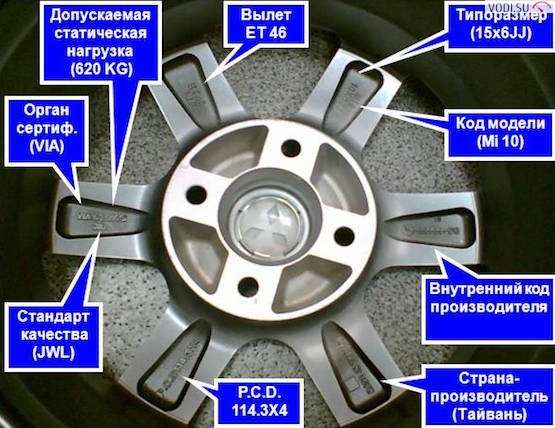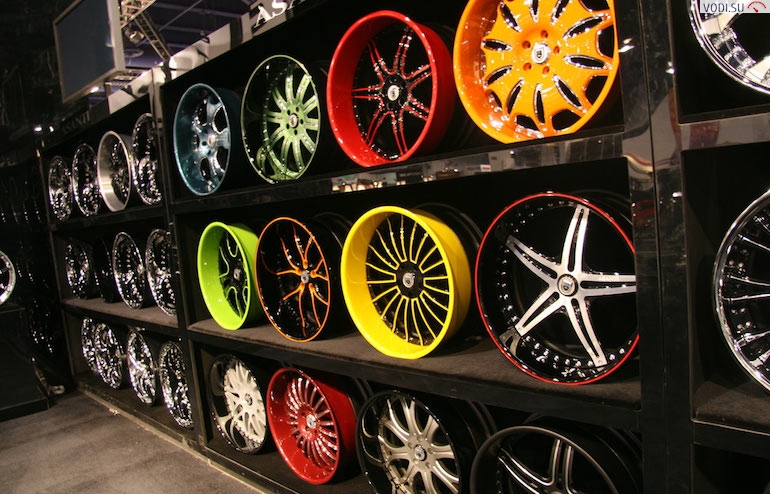
Marking of rims - decoding of the marking and place of application
When replacing tires, be sure to check the safety of the rims. If you notice any bumps or cracks, you can do it in two ways:
- take them in for repair
- purchase new ones.
The second option is more preferable, and the question arises - how to choose the right wheels for a particular rubber size. To do this, you need to be able to read the marking with all the symbols. Ideally, of course, any car owner knows what size he needs. In extreme cases, the sales assistant will tell you.
The main parameters
- landing diameter D - the diameter of the part on which the tire is put on - must correspond to the diameter of the tire (13, 14, 15 and so on inches);
- width B or W - also indicated in inches, this parameter does not take into account the size of the side flanges (humps), which are used to more securely fix the tire;
- diameter of the central hole DIA - must match the diameter of the hub, although special spacers are often included, thanks to which the discs can be mounted on a smaller hub than the DIA;
- PCD mounting holes (bolt pattern - we already talked about this on Vodi.su earlier) - this indicates the number of holes for the bolts and the diameter of the circle on which they are located - usually 5x100 or 7x127 and so on;
- departure ET - the distance from the point of fixation of the disk on the hub to the axis of symmetry of the disk - it is measured in millimeters, it can be positive, negative (the disk seems to be concave inward) or zero.
Example of marking:
- 5,5 × 13 4 × 98 ET16 DIA 59,0 is an ordinary stamped wheel that fits, for example, on the VAZ-2107 under the standard size 175/70 R13.
Unfortunately, on almost no website of an online tire store you will find a calculator with which you can get the exact marking for a specific tire size. In fact, you can do it yourself, just learn one simple formula.

Wheel selection according to tire size
Suppose you have winter tires 185/60 R14. How to choose a disk for it?
The most basic problem arises with determining the width of the rim.
It is very easy to define it:
- according to the generally accepted rule, it should be 25 percent less than the width of the rubber profile;
- the width of the tire profile is determined by translating, in this case, the indicator 185 into inches - 185 is divided by 25,5 (mm in one inch);
- subtract 25 percent from the result obtained and round;
- comes out 5 and a half inches.
The deviation of the rim width from ideal values can be:
- a maximum of 1 inch if you have tires no more than R15;
- a maximum of one and a half inches for wheels over R15.
Thus, a 185 (60) by 14 disc is suitable for 5,5/6,0 R14 tires. The rest of the parameters - bolt pattern, offset, bore diameter - must be specified in the package. Please note that it is advisable to buy wheels exactly under the tire. If they are too narrow or wide, then the tire will wear out unevenly.
Often, for example, when a buyer is looking for the wheels he needs by the PCD parameter, the seller can offer him wheels with a bolt pattern that is slightly different: for example, you need 4x100, but you are offered 4x98.

It is better to refuse such a purchase and continue the search for a number of reasons:
- of the four bolts, only one will be tightened to the stop, while the rest cannot be fully tightened;
- the disk will “hit” the hub, which will lead to its premature deformation;
- you can lose bolts while driving and the car will simply become uncontrollable at high speeds.
Although it is allowed to buy disks with a bolt pattern in the big direction, for example, you need 5x127,5, but they offer 5x129 and so on.
And of course, you need to pay attention to such an indicator as ring protrusions or humps (Humps). They are needed for a more secure fixation of a tubeless tire.
Humps can be:
- only on one side - H;
- on both sides - H2;
- flat humps - FH;
- asymmetric humps - AN.
There are other more specific designations, but they are mainly used when it comes to the selection of sports discs or exclusive cars, so they are usually ordered directly from the manufacturer and errors are practically excluded here.
Departure (ET) must comply with the manufacturer's requirements, because if it is shifted to the side more than necessary, the load distribution on the wheel will change, which will suffer not only tires and wheels, but the entire suspension, as well as body elements to which shock absorbers are attached . Often the departure is changed when the car is being tuned. In this case, contact professionals who know what they are doing.

Often you can also find the letter J in the marking, which denotes the edges of the disk. For ordinary cars, there is usually a simple designation - J. For SUVs and crossovers - JJ. There are other designations - P, B, D, JK - they more accurately determine the shape of these rims, although most motorists do not need them.
Please note that the correct choice of wheels, like tires, affects traffic safety. Therefore, it is not recommended to deviate from the parameters specified in the specification. Moreover, the main dimensions are indicated the same for any type of disc - stamped, cast, forged.
Loading…
